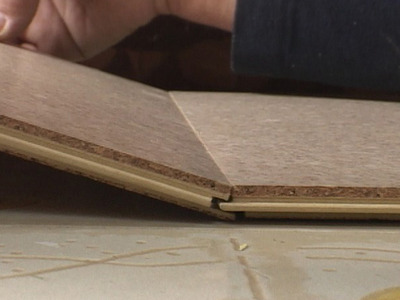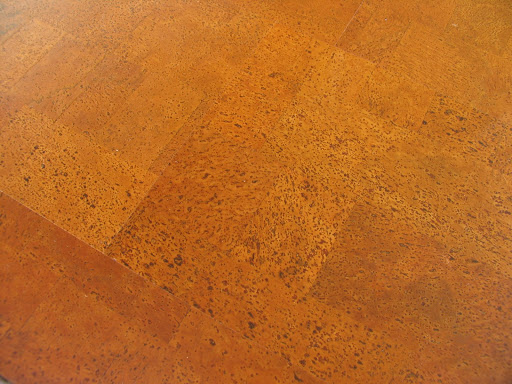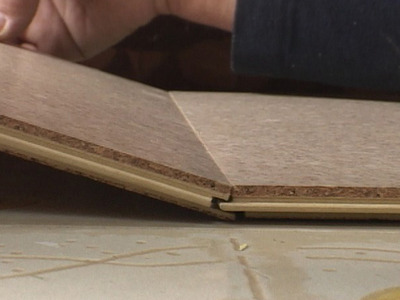We’ve talked about our cork test in regards to durability, but we thought we’d share some more information about cork and what to look for if you’re thinking about using it in your house.
1. If harvested correctly, cork is an inherently sustainable material. Not only is it rapidly renewable, but it also contains a natural waxy substance called suberin, which repels insects and keeps mold and microbes at bay. It also has a little give, which makes it a great choice for kitchens or other areas where you’re on your feet most of the time.

image of cork harvesting found here.
2. With cork, you have two options: glue down tiles or a floating system. For older houses (like ours), a floating system can be advantageous since the subfloor or existing flooring that you’re covering may not be perfectly smooth and level. A floating system can “ride the waves” so to speak, while any ridges or inconsistencies would telegraph through with a glue down approach. Also, installation of a floating system might be easier for a DIY homeowner (but buyer beware, look for quality construction to ensure all the pieces will actually fit together). For glue down tiles, it is usually recommended to adhere the tiles with contact cement, which makes getting it right the first time critical. Also, for new construction or larger applications, glue down tiles have their advantages in that after the unfinished cork is installed, it can be lightly sanded to reduce the appearance of seams and then finished in place. With the plank system, a tongue and groove panel construction means you simply lock the panels in place, without a need to nail or glue it to the subfloor. However, if you’re thinking of using plank flooring, look closely at the build-up. Typically, the flooring sandwich is composed of a thick piece of cork underlayment, a layer of hdf (high density fiberboard), and then the top layer of compressed cork (with or without a cork veneer over that). The glue used in the hdf or between the layers of materials can sometimes contain formaldehyde so check with the manufacturer to be sure. The appeal of natural cork certainly diminishes if you’ve got all sorts of crazy chems and VOC’s underneath!

image found here.
3. Which brings us to finishes – there seems to be two camps when it comes to finishing cork. Some products come prefinished with a coating of polyurethane while others are prefinished with a hardwax oil (and of course some come unfinished). The polyurethane is durable but sometimes has that plasticky look. We’ve also been told that it is hard to spot repair if you get a deep scratch. The hardwax oil (Osmo is a popular brand sold at Ecohaus) has a bit more elasticity to it and can be spot repaired. In fact, if you’re good about repairing scratches and blemishes as they happen, you may never have to refinish the entire floor.
4. Now for the fun part, colors. These days, there is a huge variety of cork options. Of course, there are the standard “corkboard” natural colors but there are also some interesting darker colors that have been achieved by steaming the cork (similar to carmelizing food). The great thing about going this route is you get a through body color (meaning what you see on the top is the same through the entire top layer). For most of the other options, the pattern or color is achieved by a thin veneer over the natural cork. The disadvantage to a veneered cork is that if it does get a deep scratch, you would see the natural cork color below. We were concerned about this at first (since we really like one of the veneered options) but after our multi-month “scratch test” we’re feeling pretty confident. Besides, we hope to someday have a “no shoes” policy that would prevent any stiletto punctures.

Image found here.
After considering all these factors, we are happy with our choice from Ecohaus – a 1’x3′ plank floating system that is formaldehyde free with a hardwax oil finish. We also love that cork is noticeably warmer than most other floor surfaces (at the molecular level, cork has tons of little air pockets which make it a better insulator)!
So there you have it, the low down on all things cork. Stay tuned for the next segment in which we hope to talk about how ridiculously easy it was to install!

[…] I know, I know…we talked about cork here and here, and completely had our minds made up here, but as things evolve we are rethinking our flooring one more time. Bottom line – we still […]
[…] some additional tips to add. (You can also read more about our cork selection process here, here, here and here.) So far, we’re really pleased with how it turned out. In fact, we have (as of […]
Hello – I have been researching cork flooring options and would love to know the brand you chose from Ecohaus. We installed a cork plank floor in a home in Portland https://16swabernathy.wordpress.com/ and we loved it, though we did see some fading due to direct sunlight exposure (even in Portland!). We’ve relocated twice since this house and we’re renovating a 1990s home now. The number of cork options have multiplied exponentially. I like the idea of using a wax/oil finish. I am also looking for a product that does not contain formaldehyde and won’t offgas a ton of VOCs, though I think all HDF products have some VOCs. I understand if you can’t post the cork brand name on your blog but can you email me with the best you’ve found? Your research will really be helpful for us.
Thank you,
Julianna
Hi Julianna, here’s a post that gives the rundown on the cork we used: http://zerbey.wpengine.com/2010/10/17/installing-cork-flooring/
We used just natural cork, so no issues with offgassing (the glue we used was zero-VOC too). We have had some fading at the back door, but we also used the darker cork. The wax/oil finish isn’t as bullet-proof as the poly, but if you don’t have a dog I’d say it’s still a good bet. If you do have a dog, I’m on the fence. I’d be curious to see how a floor with poly holds up to dog paws. =)